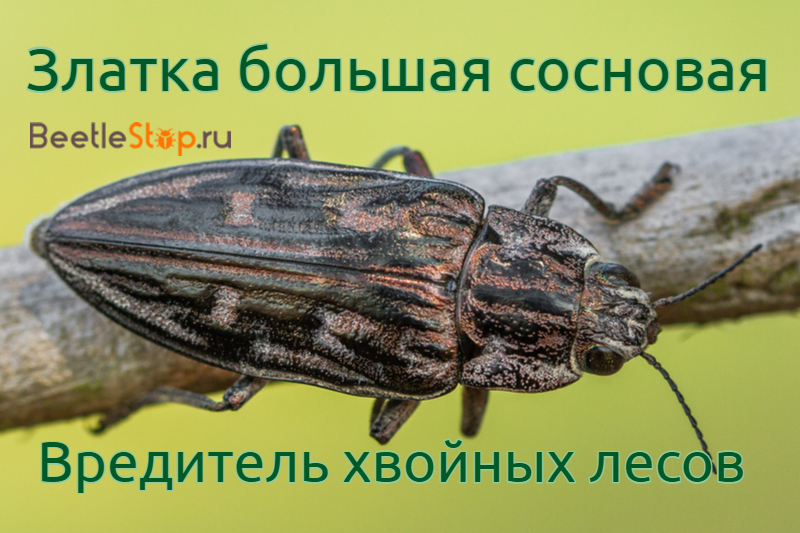Large pine gilding: features of species from the Buprestidae family
A large family of goldfish beetles (Buprestidae) united more than 15 thousand species. Insects live in all corners of the earth except the Arctic and Antarctic. The greatest variety of beetles can be found in tropical forests. In Russia, 400 species of the Buprestidae family were found. Representatives of most of them harm forestry and agriculture to varying degrees. Large pine bark - a typical species that spoils pine trunks. In some areas of the Russian Federation, he was threatened and was listed in the Red Book.

Species of the Buprestidae Family
The Russian name of the beetles characterizes the peculiarity of their color. Insects come in different colors (copper, green, blue, black), but at the same time they have a metallic luster. They look especially impressive under the sun. Body sizes 5-100 mm, the largest specimens live in the tropics. European species are much more modest in size, their length is slightly more than 30 mm. Beetles live and feed on trees and shrubs. Larvae of certain species feed on dry trunks, but most prefer live wood.
Among the common groups:
- Blue pine gilding (Phaenopscyanea) - an insect with elytra of blue-violet or bronze-green color. It is a pest of conifers, especially pine. The average adult size is 7-12 mm, the larvae are 25 mm. Years of beetles in June-July. Females lay eggs under the bark on the south side. Larvae gnaw through flat passages around the trunk. Overwinter in the thickness of the bark, pupate in May next year. Annual generation.
- Firebird (Melanophilaacuminate) - an adult black, body length 6-13 mm. Polyphage larvae live on all species of conifers, in the USA - on thuja and cypress. Beetles often lay eggs in conflagrations, in cracks formed on the bark of trees. In the process of development, the larvae are buried in the wood in the lower part of the trunks, can settle on the roots. Biennial development.
Description of the species Chalcophoramariana
Big pine gilding is one of two species of the genus Chalcophora that live in Russia. It is also called large goldfish. Adults are distinguished by the largest sizes among European species. Body length 23-32 mm. Beetles are found in pine and mixed forests. Body color varies from copper-bronze to almost black. Strong integument in dense puncture. The head is vertical, eyes are large, widely spaced. Insects have good eyesight and are hard to catch by surprise. Antennae short, serrate.
Information. In case of danger, the beetles bend their legs and antennae, and then fall from the tree, pretending to be dead.
Regrouped, with longitudinal dents and hairs. The head, chest and elytra of beetles bear smooth longitudinal keels. At the elytra, they are interrupted by four pits with a characteristic copper-green shine. The apex of the elytra is slightly jagged; at the end, they noticeably narrow. Beetles have three pairs of short strong legs. Adults move quickly on land and trees. Claws and spikes help to stay on a vertical surface. Rigid elytra completely hide the abdomen and well-developed wings. The flight of the imago is quick and easy. Sexual dimorphism is manifested in the structure of anal sternitis. The males have a copulative organ in the last segment, and the female has a retracting ovipositor.
Lifestyle
The species is common in Central and Southern Europe, found in the Urals, southern Siberia to Lake Baikal. Insects are noted in the mountainous regions of West Asia, North America. Mixed and pine forests growing on sandy soils are typical habitats.
Information. Chalcophoramariana beetles are a thermophilic species. Adults spend a lot of time on the south side of trunks or tree stumps, basking in the sun.
The adult years begin in May and last until August. Beetles fly in the daytime over a limited area, without moving away from their usual habitats. Most often they can be found at the felling. Sometimes adults lay eggs on pine trees damaged by fires.
Breeding
Females lay eggs in the crevices of pine bark. The embryo develops for two weeks. Young larvae bite into the bark, where they make wide passages. Over time, they grow to 80 mm. Worm-shaped larvae with an expanded prothorax, into which the head is drawn. The color is white. Abdomen elongated, limbs absent. The development of the larva takes 3-6 years. Before pupation, she constructs a 4 cm long pupal chamber. The pupal phase is up to 28 days.
In the Tula and Smolensk regions, as a result of deforestation, the amount of large pine gold leaf has decreased. Beetles were listed in the regional Red Book.

